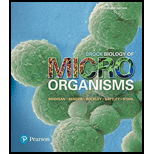
Brock Biology of Microorganisms Plus Mastering Microbiology with Pearson eText -- Access Card Package (15th Edition)
15th Edition
ISBN: 9780134268668
Author: MADIGAN
Publisher: PEARSON
expand_more
expand_more
format_list_bulleted
Question
Chapter 16.7, Problem 1MQ
Summary Introduction
Staphylococcus is a gram-positive, facultative anaerobic bacteria, appears grape-like clusters in agar plate. They are usually harmless, if it inhabits the nose and the skin. Streptococcus is a gram-positive bacterium occur in pairs or chains. It is considered as the normal flora of the throat and the skin.
Expert Solution & Answer
Want to see the full answer?
Check out a sample textbook solution
Students have asked these similar questions
How could species of Staphylococcus be differentiated fromStreptococcus?
How does one can differentiate Streptococcus pyogenes from Staphylococcus
What characteristics differentiate Sarcina from Staphylococcus?
Chapter 16 Solutions
Brock Biology of Microorganisms Plus Mastering Microbiology with Pearson eText -- Access Card Package (15th Edition)
Ch. 16.1 - What are some ways in which Wolbachia species can...Ch. 16.1 - Prob. 2MQCh. 16.1 - Which genera of Alphaproteobacteria are known to...Ch. 16.2 - Prob. 1MQCh. 16.2 - Prob. 2MQCh. 16.2 - Prob. 1CRCh. 16.3 - Prob. 1MQCh. 16.3 - Prob. 2MQCh. 16.3 - What is the catalase test? What catalase reaction...Ch. 16.4 - What species of Pseudomonas is a common cause of...
Ch. 16.4 - What major characteristic could be used to...Ch. 16.4 - Prob. 1CRCh. 16.5 - What four metabolic traits are most common in...Ch. 16.5 - Why is Wolinella physiologically unusual among the...Ch. 16.5 - Prob. 1CRCh. 16.6 - Prob. 1MQCh. 16.6 - How can Streptococcus pyogenes be distinguished...Ch. 16.6 - What is the difference between homofermentative...Ch. 16.7 - Prob. 1MQCh. 16.7 - What characteristics differentiate Sarcina from...Ch. 16.7 - What characteristics of Listeria make it a...Ch. 16.8 - What is the major physiological distinction...Ch. 16.8 - What is the crystalline protein made by Bacillus...Ch. 16.8 - What is a good strategy for isolating...Ch. 16.9 - Prob. 1MQCh. 16.9 - Prob. 2MQCh. 16.9 - Prob. 1CRCh. 16.10 - What is snapping division and what organism...Ch. 16.10 - What organism is involved in the production of...Ch. 16.10 - Prob. 1CRCh. 16.11 - What is mycolic acid, and what properties does...Ch. 16.11 - Prob. 1CRCh. 16.12 - Prob. 1MQCh. 16.12 - Prob. 2MQCh. 16.12 - How are the spares of streptomycetes different...Ch. 16.13 - Prob. 1MQCh. 16.13 - What species of Bacteroidetes is most abundant in...Ch. 16.14 - Describe a method for isolating Cytophaga species...Ch. 16.14 - Prob. 2MQCh. 16.14 - Prob. 1CRCh. 16.15 - How are Chlamydia and Mycoplasma (Section 16.9)...Ch. 16.15 - Prob. 2MQCh. 16.15 - Prob. 1CRCh. 16.16 - Prob. 1MQCh. 16.16 - Prob. 2MQCh. 16.16 - What are two types of intracellular compartments...Ch. 16.17 - Prob. 1MQCh. 16.17 - Prob. 1CRCh. 16.18 - What is unique about the genome of Thermotoga and...Ch. 16.18 - Prob. 1CRCh. 16.19 - Prob. 1MQCh. 16.19 - Prob. 1CRCh. 16.20 - Describe a commercial application of Thermus...Ch. 16.20 - Describe an unusual biological feature of...Ch. 16.20 - What are some of the remarkable properties that...Ch. 16.21 - Prob. 1MQCh. 16.21 - Prob. 2MQCh. 16.21 - Prob. 3MQCh. 16.21 - Prob. 1CRCh. 16 - Enteric bacteria, lactic acid bacteria, and...Ch. 16 - Microorganisms can have a variety of different...
Knowledge Booster
Learn more about
Need a deep-dive on the concept behind this application? Look no further. Learn more about this topic, biology and related others by exploring similar questions and additional content below.Similar questions
- What is the value of differentiating S. aureus from other species of staphylococci?arrow_forwardWhat property of Staphylococcus epidermidis helps it to colonize plastic materials used in medical procedures?arrow_forwardWhy is an organism such as Staphylococcus adapted to growth on the human skin whereas the streptococci are generally not?arrow_forward
- What is the difference between the use of the shape bacillus and the name Bacillus? Staphylococcus and staphylococcus?arrow_forwardHow can we differentiate a Bacillus cereus from B. subtilis if both are beta hemolysis?arrow_forwardWhat did Staphylococcus avoid characteristics and descriptions of laboratory procedures and method Staphylococcus? Are the healthcare concerns, infections, and nosocomial infections discussed for genera Staphylococcus? Does Staphylococcus avoid characteristics and descriptions of laboratory procedures and methods?arrow_forward
arrow_back_ios
SEE MORE QUESTIONS
arrow_forward_ios
Recommended textbooks for you

Bacterial Infections in Humans; Author: Professor Dave Explains;https://www.youtube.com/watch?v=FeFKAl9KyMg;License: Standard Youtube License